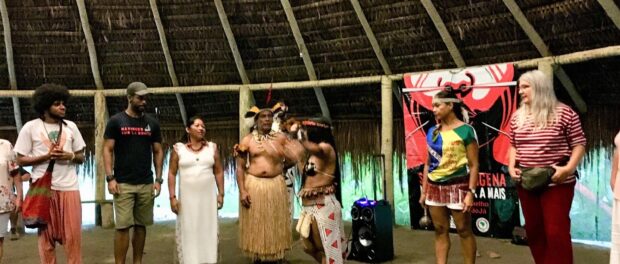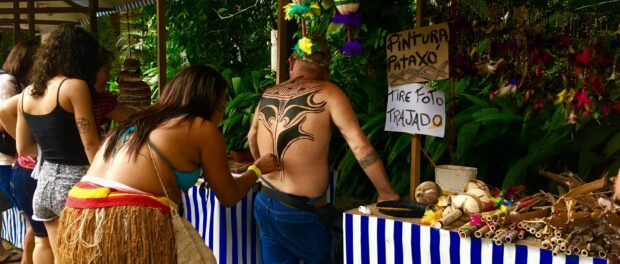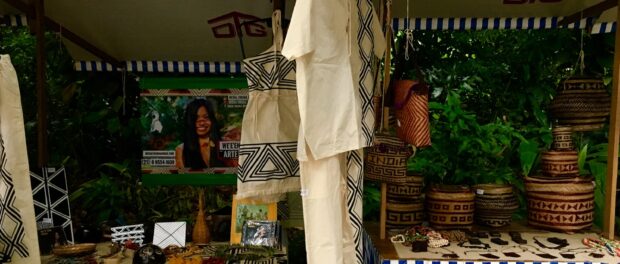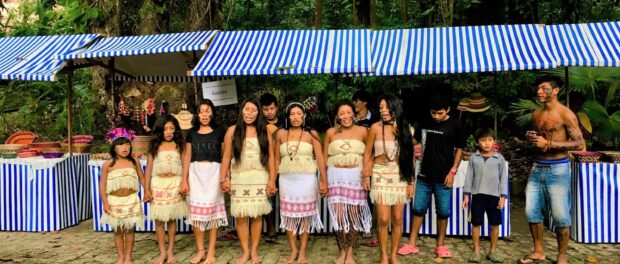
On April 13 and 14, the largest indigenous cultural event in Rio de Janeiro took place: Indigenous Peoples’ Day in Parque Lage. In partnership with the Parque Lage School of Visual Arts (EAV), the Aldeia Maracanã Indigenous Association (AIAM) opened up a space for the exhibition and sale of traditional indigenous crafts, presentations by cultural groups, and discussion circles and debates on contemporary indigenous issues.
AIAM, an example of indigenous resistance, has welcomed and brought together indigenous people of different ethnicities in the urban context of the city of Rio de Janeiro since 2006. To commemorate Indigenous Peoples’ Day, the association assembled over one hundred Brazilian indigenous people belonging to the Pataxó, Guaraní, Tukano, Tikuna, Purí, Potiguara, Guajajara, Huni Kuin, Ashaninka, and Uitoto ethnicities, among others.
In coming together, indigenous peoples are able to recognize their practices and beliefs, thus allowing for the preservation of their ancient cultures. Furthermore, these types of encounters serve as opportunities for the convergence of narratives, exchange of strategies, and interaction between indigenous and nonindigenous people. It is necessary to create cultural gateways between people, “strengthening the spirit and cultivating the force to win this battle—which belongs not only to indigenous peoples, for it should be a battle of humankind,” said Tobi Itaúna, a pajé (medicine man) and the owner of a medicinal herb shop. In the context of the current scenario in Brazil, unity must prove stronger than ever given the imminent risk to the cultural wealth and diversity of indigenous peoples.
Land: The Importance of a Recurring Debate and What It Means for Indigenous Culture
Without a doubt, the focal point of the discussion circles and debates was the issue of land conflict. Since 1500, the colonial system has subjugated indigenous peoples living on the invaded lands, dispossessing them of their cultures and their homes. Reparations are incomplete given the lack of governance in the most affected regions, flexible environmental regulations, and damaging forms of prejudice. These factors make land rights a fully contemporary issue and a necessary debate to foster.
We constantly see large development projects that serve as the “engine of the economy.” However, these projects infringe on protected areas. In effect, the forest is in great peril due to the rapid pace of exploitation and the desire for unsustainable economic growth that undermines constitutional rights and international treaties. As such, the demarcation of indigenous territories (TIs) in Brazil has become the focal point of these debates as it is one of the few mechanisms that tacitly guarantees the protection of the forests and the people who depend on them to sustain their lives.
For indigenous peoples, land is more than the space that sustains the natural resources therein. During one of the debates at the event, held in the large Kupixawa oca, Tobi Itaúna said that we must be conscious of the “importance and value of the land.” He stated that nature provides the necessary conditions for the physical and cultural reproduction of indigenous peoples and that to attack the land is to attack the communities that inhabit it.
Tobi Itaúna concluded his moving speech by saying that indigenous peoples want land in order to “save the planet” because “where there is land, there are forests and where there are forests, there is water”—the elements that sustain the basis of our existence. Indeed, indigenous territories are the areas with the highest degree of environmental preservation in Brazil.
However, the situation does not seem to be progressing with the current Brazilian president’s promise to ensure that protected indigenous lands won’t expand by even a centimeter. Therefore, the threshold of rights conquered wavers in the face of obstruction by the government.
The War Declared by the Government on Indigenous Peoples
“The day when there is no place for the indigenous in this world, there will be no place for anyone,” once said Ailton Krenak, one of the great leaders of the Brazilian indigenous movement, known for his speech at the National Constituent Assembly in 1987 in defense of the constitutional amendment for the Union of Indigenous Nations. The amendment was considered a victory because it recognized indigenous peoples and their land in the Brazilian nation for the first time.
However, government institutions are those that most harm traditional peoples. In little more than one hundred days, the current administration’s attacks have been direct and mercenary. On his first day in office, Bolsonaro decreed Provisional Measure (MP) 870/2019, which seeks to transfer the recognition of indigenous territories from the Ministry of Justice to the Ministry of Agriculture, Livestock, and Supply, which is headed by Brazil’s agribusiness caucus. Likewise, the National Indian Foundation (FUNAI)—the federal agency responsible for indigenous issues—would be sapped and stripped of the responsibilities conferred upon it over fifty years ago. Shortly thereafter, the administration proposed to dismantle the Special Secretariat of Indigenous Health (SESAI). Yet more, members of the Social Liberty Party (PSL) such as representative Rodrigo Amorim have incited hate and prejudice against indigenous peoples, including slandering Aldeia Maracanã.
This disrespect for the constitutional rights of indigenous peoples is linked to grave problems with regard to deforestation, the invasion of protected areas, illegal logging and mining activities, benefits reaped by corporations, and threats to safety of indigenous leaders.
Call for All Indigenous Peoples and the 2019 Free Land Encampment
“They didn’t manage to destroy our roots. Resist, in order to fight. Live and fight until death and never kill. Let us all have strength! Brothers, together we are stronger,” recited an indigenous community leader at the closing ceremony of the event in Parque Lage. The strong political aspect of the event made indigenous peoples’ desire to continue fighting against the erosion of their rights very clear. As such, from April 24 to 26, representatives of indigenous communities across Brazil gathered at the Esplanade of Ministries in Brasília, Brazil’s capital. The occupation of this space is known as the Free Land Encampment (ATL), organized by the Articulation of Indigenous Peoples of Brazil (APIB). The annual occupation features cultural activities, political demonstrations, lectures, and interaction with figures from various fields to discuss the uncertain future of different ethnic groups.
The Pataxó leader Arassari Pataxó said during one of the lectures that the mobilization “will begin on April 24, but it will continue until he [the Brazilian president] learns to respect [indigenous peoples].” He added: “We have been here since before Brazil was colonized, for thousands of years. A president will not destroy us now.” During the event, several leaders reiterated that they are counting on the support of the Brazilian people.
Perspectives on the Future
Two days of song, culture, debate, and political organizing among indigenous peoples generated results. President of AIAM Marize Guaraní bid the audience farewell with the following words: “Go home happy with a sense of satisfaction, but also with your spirits full of energy from being here, dreaming together, and together giving rise to other dreams and struggles that we will certainly need to fight in the coming months.”
Commemorations like this allow for the demystification of “the other”—putting an end to the ignorance surrounding what it means to be indigenous, indigenous peoples’ ways of thought, and the basic necessary conditions to sustain their existence. These encounters also give rise to collective action, generating the strength to continue making injustices visible, denouncing abuses, and protecting indigenous rights.



